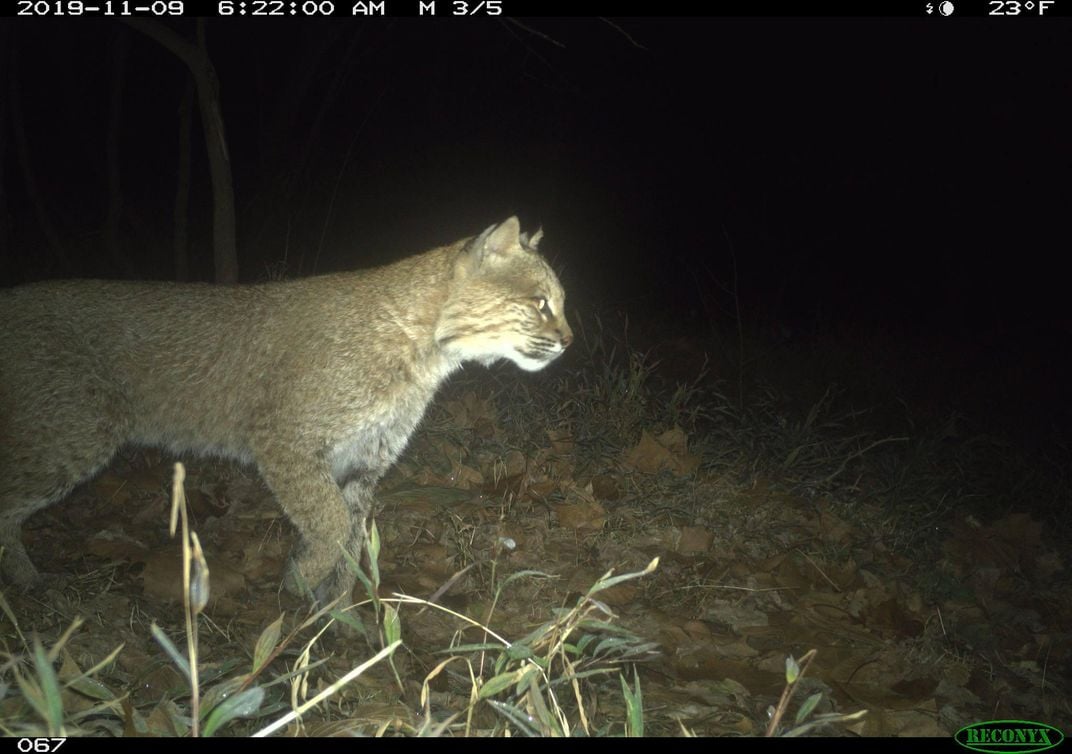Unusual Urban Bobcat Spotted in Washington, D.C.
The closest verified bobcat sighting was 25 miles away, so how this one reached the city remains a mystery
/https://tf-cmsv2-smithsonianmag-media.s3.amazonaws.com/filer/17/3c/173c6801-3105-4a1d-85c1-162c9a6685ce/2020_jan15_bobcat1.jpg)
Last November, a mutton-chopped visitor was spotted prowling on the edges of Georgetown. It wasn’t the ghost of Martin van Buren—it was a bobcat.
The small wildcat was caught by a camera trap placed near the Chesapeake and Ohio Canal by DC Cat Count. DC Cat Count’s goal is to better understand domestic and feral housecat populations around the U.S. capital. The potentially 30-pound feline came as a surprise to field technician Dan Herrera, who was reviewing a backlog of photographs generated by automated wildlife cameras.
“It was the usual, squirrel, rabbit, squirrel, rabbit, deer. And then all of a sudden there was a bobcat.” Herrera tells WAMU’s Jacob Fenston. “I was awestruck, to be completely honest.”

Dan Rauch, a wildlife biologist at D.C.'s Department of Energy & Environment, confirmed for Fenston that the creature in the photo is a bobcat, based on its distinctive fur patterns and stubby tail. It’s also the first wild cat of its kind spotted in D.C. in recent history. (Although, in 2017, a National Zoo bobcat named Ollie escaped her enclosure and was found on Zoo property a few days later.)
Bobcats are found in the wild across the contiguous 48 states but were mostly pushed out of urban areas on the east coast. They’re slightly less adaptable animals than typical urban wildlife like coyotes and foxes, ecologist Michael Cove of North Carolina State University tells Douglas Main at National Geographic, and East Coast bobcats are usually quite shy. Cove adds that the nearest sighting was 25 miles away from D.C. in Loudoun County, Virginia, and says it wouldn’t be unusual to find bobcats in less developed areas nearby.
At between 25 and 35 pounds, bobcats are smaller than most dogs, so this one is unlikely to pose a threat to local pets. Wildlife biologist Julie Young studied bobcat scat in the Dallas-Fort Worth area for signs of their regular diets, and found no proof that pets were preyed on, per National Geographic.
Bobcats tend to hunt smaller prey, like rabbits, squirrels, and mice, so this one might be feasting on Georgetown’s many cottontails, DCist’s Natalie Delgadillo suggests.
The sighting also “speaks to the quality of green space that D.C. has to offer,” Travis Gallo, an urban ecologist at George Mason University in Virginia, tells Main. The C&O has been part of the National Park Service’s initiative to improve parks in the city for years, so future cat counting, both by the Humane Rescue Alliance’s project and by camera traps that Gallo’s lab is now putting up, will give insight into the cat’s behavior. Given that East Coast cats are wary of busy urban centers, additional research will reveal whether bobcats are making D.C. their home, or simply visiting on their way to another destination.
Bobcats further west, however have been faster than their East Coast cousins to enter city life. Young tells Main that around Dallas, bobcats have begun to show up on golf courses, underpasses, and even a Home Depot parking lot. Bobcats have also been spotted on the fringes of Portland, Oregon, where one juvenile bobcat was euthanized by state officials after entering a local school late last year, reports Oregon Public Broadcasting's Erin Ross. (The decision to euthanize was highly scrutinized by verterinary groups and local residents and is currently being reviewed by Oregon lawmakers.)
“There’s no reason to persecute bobcats. They don’t carry away small children — we should have no fear of bobcats,” wildlife ecologist Jim Sanderson of Small Wild Cat Conservation Foundation tells WAMU. “We have to open up our eyes and start thinking about tolerance. How do we live around these animals, tolerate their existence, just like they tolerate ours?"